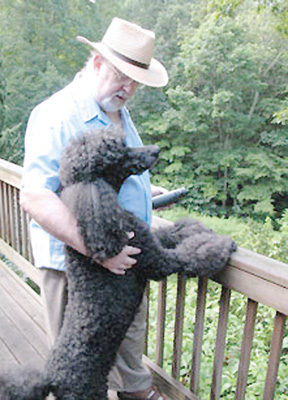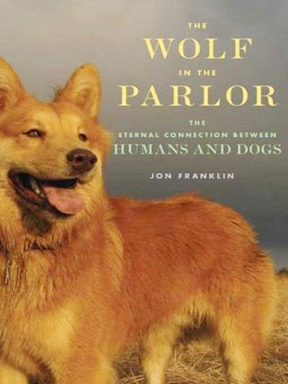Without Dogs, Where Would Humans Be?
Pulitzer Prize-winning Marylander Jon Franklin says maybe we wouldn’t be

“The dog has a way of helping us get in touch with our feelings,” says Jon Franklin, shown here with his standard poodle Sam.
|
distributed by Maryland-Delaware-D.C. Press Association
The first dogs probably saved our ancestors’ lives at the end of the last ice age, says Marylander Jon Franklin, whose lucid explanations of brain science earned him two Pulitzer Prizes and put him in the Maryland-Delaware-D.C. Journalism Hall of Fame.
Franklin explains what happened in his new book, The Wolf in the Parlor, (HHolt, 2009) a nonfiction mystery that begins with a 12,000-year-old grave. Uncovered by archeologists working near the Syrian-Israeli border, the grave contained the bones of an old man and what appeared to be a puppy. In studying the photograph, Franklin was struck by two things. The old man lived and died at the exact moment in history when early humans ceased their aimless wandering and started building civilization. But it was the way the man’s hand stretched toward the puppy that disturbed Franklin. The gesture was poignant and uncomfortably familiar.
“It wasn’t so odd to find the puppy’s bones in the grave,” Franklin said. “Humans were often buried with animals. But the way the man was reaching for the puppy … that photograph haunted me.”
Thus began a 10-year search for an explanation for the human/dog bond.
“I didn’t know what I’d find,” Franklin said, “but the result was a total surprise. In fact, if you don’t take it step by step, the conclusion sounds downright bizarre.”
Herding Partners
As the ice retreated, he said, the ecosystem changed rapidly. This was not just a rough patch; it was an age of extinction. Since humans were living on the creatures that were disappearing, they could well have died off with the rest of the ice age menagerie. Instead humans and a subclass of gray wolf partnered to protect the diminishing food supply from other predators. In effect, the wolf-dogs and the humans became herders, rounding up and protecting animals like the caribou from the feral wolves.
The pressure to adapt or die led to dramatic changes in both humans and protodogs. Some of the changes were obvious from the outside: The dogs developed shorter snouts and lighter bodies. But the most dramatic and important changes were in their brains. Brain tissue is very expensive, biologically, and that which is not used is quickly lost. Within a few thousand years the dog lost 20 percent of its brain mass as it turned the thinking and scheming over to the human, who was better at it anyway.
How Big Is Your Brain?
“Now here comes the bizarre part,” Franklin said. “At the same time, the human lost perhaps 10 percent of its brain matter.
“It’s such an odd notion that at the moment our ancestors grew more intelligent, they lost brain mass. We’ve always assumed that our large brains were what separated us from the rest of the animal kingdom. Heck, science fiction stories portray humans of the future as having huge heads to accommodate the growing brain.
“So the loss of 10 percent of the human brain seemed inexplicable. But now it seems a sure bet that what functions were lost were taken up by the dogs. People specialized in smarts, and dogs specialized in feeling, instincts, smells and the like. Those abilities are critical to psychological survival but, in the human, they often interfered with the ability to focus intellectually. So losing those particular brain cells actually made people smarter.”
Dogs, meanwhile, became emotional beasts of burden. They were the ones who were paranoid at night, who checked out suspicious noises and smells, and they were also the ones who added the soulful feelings that humans had largely lost.
It was a match that allowed both animals to survive one of the most treacherous moments in evolutionary history — but it forever fused them into a tight psychological symbiosis that persists into modern times. Human and dog became human/dog.
  Though few of today’s dogs maintain their historical roles of hunters, herders and ratters, they nevertheless continue to carry that emotional brainpower that the human lost. This gives them a unique usefulness in stimulating people’s emotions, soothing psychic pain and connecting us with nature. Though few of today’s dogs maintain their historical roles of hunters, herders and ratters, they nevertheless continue to carry that emotional brainpower that the human lost. This gives them a unique usefulness in stimulating people’s emotions, soothing psychic pain and connecting us with nature.
“The dog has a way of helping us get in touch with our feelings,” Franklin said. “That’s why they’re used by psychiatrists and treatment facilities. Autistic children who can’t relate to people, for example, can often relate to dogs. And it’s no statistical fluke that people who have dogs live longer than people who don’t. They have less angst.
“This kind of ability is not a product of socialization or an accident of nature. It is a distinct mental ability that has to have a specially evolved set of neurons to make it possible.”
The intricacies of all this required more than 10 years for Franklin to untangle and to write The Wolf in the Parlor. But what was difficult to figure out, scientifically, is easy to experience. Get in touch with your dog. You will feel better for it — and it will make you more human.
Jon Franklin explains the mystery of The Wolf in the Parlor at 7-8:30pm Th April 22 @ Calvert Library, Prince Frederick: 410-535-0291; www.calvert.lib.maryland.us.
|
![]()



 Though few of today’s dogs maintain their historical roles of hunters, herders and ratters, they nevertheless continue to carry that emotional brainpower that the human lost. This gives them a unique usefulness in stimulating people’s emotions, soothing psychic pain and connecting us with nature.
Though few of today’s dogs maintain their historical roles of hunters, herders and ratters, they nevertheless continue to carry that emotional brainpower that the human lost. This gives them a unique usefulness in stimulating people’s emotions, soothing psychic pain and connecting us with nature.